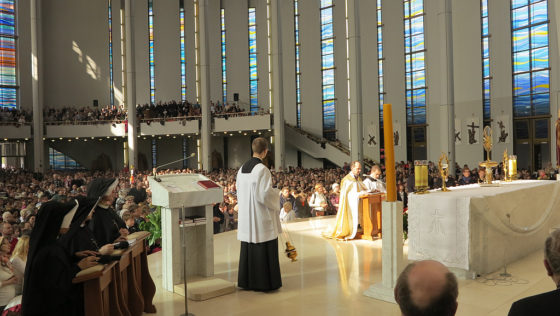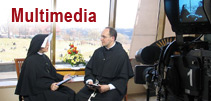It was in February 1931, in the Church in Płock, that the Lord Jesus first spoke to Sister Faustina about the desire to establish this feast, and He returned to this issue in several revelations. No wonder that at first only Sister Faustina celebrated this feast according to the wishes and recommendations of Jesus (cf. Diary 280, 89, 420, 1073-1074), seeing that her role in this task consisted not only in informing her Vilnius spiritual guide about Jesus’ words, but also in supporting his efforts with her prayers and suffering. Father Michał Sopoćko wrote theological articles and dissertations, in which he sought to justify the need for this feast in the liturgical calendar of the Church and to show the benefits it would bring for pastoral care. He sought support for this idea among theologians and bishops, and even went to Rome to submit the matter personally to the Congregation.
The 1959 Notification of the Holy See, which prohibited spreading devotion to the Divine Mercy in the form given by Sister Faustina, hampered efforts to establish the feast, but did not disturb the work of theologians, among whom were both zealous advocates of its institution and its strong opponents. After the cancellation of the Notification by the Holy See in 1978, and a complete analysis of Sister Faustina’s writings conducted by Father Ignacy Różycki, and following the publication of Pope John Paul II’s encyclical, Dives in Misericordia, Cardinal Franciszek Macharski, Archbishop of Kraków, in his 1985 Lenten letter, established the Feast of The Divine Mercy in his diocese. In subsequent years, bishops of other dioceses followed the Archbishop of Kraków’s lead. In 1995, the Holy Father John Paul II, acceding to the request of the Primate, Cardinal Józef Glemp, and of the Polish Episcopal Conference, agreed to introduce this feast to the liturgical calendar of the Church in all the dioceses in Poland. On the canonization day of Sister Faustina, on the first Sunday after Easter, 30 April 2000 – the Holy Father established the Feast of The Divine Mercy for the whole Church. In the document of the Congregation for Divine Worship and the Discipline of the Sacraments, we read:“Pope John Paul II has graciously commanded to add to the Roman Missal the term ‘Divine Mercy Sunday’ after the title ‘Second Sunday after Easter,’ and ordered that the texts must always be used as given in the Missal for this Sunday’s liturgy and in the Liturgy of the Hours of the Roman Rite.” The Congregation announced these provisions of the Holy Father on 5 May 2000 stating that they should be executed “regardless of any regulations to the contrary.”
With the consent of her confessors, Sister Faustina first began to celebrate the Feast of The Divine Mercy in 1934 (cf. Diary 280). The following year she spent this feast at the Gate of Dawn in Vilnius, where the image of Merciful Jesus was exposed for public veneration for the first time (cf. Diary 89, 420). In 1937, Jesus asked for adoration to take place on that day in the convent in Kraków with the intention of imploring God’s mercy for the world (cf. Diary 1070) and for the priest to give the homily on the mercy of God. Sister Faustina recorded what happened on that feast, writing: “April 4, 1937. Low Sunday; that is, the Feast of Mercy. In the morning, after Holy Communion, my soul was immersed in the Godhead. I was united to the Three Divine Persons in such a way that when I was united to Jesus, I was simultaneously united to the Father and to the Holy Spirit. My soul was flooded with joy beyond understanding, and the Lord gave me to experience the whole ocean and abyss of His fathomless mercy. Oh, if only souls would want to understand how much God loves them! All comparisons, even if they were the most tender and the most vehement, are but a mere shadow when set against the reality. When I was united to the Lord, I came to know how many souls are glorifying God’s mercy. When I went for adoration, I heard these words: ‘My beloved daughter, write down these words, that today My Heart has rested in this convent [the Kraków house]” (Diary 1073 – 1074).
As a result of internal urges Sister Faustina was going to go alone to the Holy Father, to present the request of the Lord Jesus on the subject, but Father Sopoćko discouraged her from going to Rome and wrote: “The Feast of The Divine Mercy, which the Lord Jesus asks for through Sister, will be established without Sister going to the Holy Father, and indeed the fact of Sister personally going to Rome would not move the issue forward, but might even do some harm. One needs firstly to prepare the way, make people aware of the need for this feast, make a common request to our entire nation and especially our most honoured Cardinals, Archbishops and Bishops, after which the establishment of this feast will be only a matter of time.”
With this in mind Father M. Sopoćko wrote an essay entitled “Divine Mercy” and handed it to the bishops present at the First Plenary Synod in Czestochowa (26-27 August 1936). Although it did not bring the expected results, Father Sopoćko persisted in the actions undertaken. He continued to write articles and dissertations in order to justify theologically the need for establishing such a feast. In his work “Idea Miłosierdzia Bożego w liturgii” (The Idea of Divine Mercy in Liturgy) he emphasized that liturgical books often refer to the mercy of God, and therefore it is not a new idea, but little known to the faithful. The establishing of the feast would make way for a better understanding of this attribute of God and provide an opportunity to implore mercy for the world, which is so much needed especially in these times.
Father Sopoćko not only wrote about but also made efforts to fulfil Jesus’ request. At the Mariological Congress in Vilnius (1-3 July 1937) he put forward a proposal to send a request to the Holy See that the Feast of The Divine Mercy be established. The proposal was accepted, but Archbishop Romuald Jałbrzykowski did not agree to send it to Rome claiming that it opposed a ban of the Holy See concerning the introduction of new worship. Taking advantage of the presence in Vilnius of the Archbishop Franciszek Cortesi, Father Sopoćko brought before him the issue of the Feast of The Divine Mercy. “I spoke with the Nuncio about the Feast of The Divine Mercy” – Father Sopoćko wrote to Sister Faustina – “he promised to think about it and then summon me to discuss the details. I do not know yet whether to tell him where that idea came from. Please also pray that I may have light and pray for His Excellency Archbishop Nuncio Cortesi, who can do a lot.”
The role of Sister Faustina actually consisted mainly in prayers and sacrifices for this intention. She wrote in a letter to her confessor that “As for this feast (…) I do not have a shadow of a doubt that it is clearly the will of God. Through us God began His work; we need not inquire who will complete it, but now we should do what is in our power, nothing more.”
After the death of Sister Faustina, Father Sopoćko continued his efforts on the work in hand. In November 1938 he went to Czestochowa for the Polish Episcopal Conference to pass to the bishops a memorandum detailing reasons for the establishment of the Feast of The Divine Mercy and the blessings which would result from it. He used strictly theological arguments, since the revelations of Sister Faustina had not yet been examined by the Church, and the clear will of the Ordinary was that they should remain secret. In April 1939 Father Sopoćko went to Rome to present there the issue of establishing the Feast of The Divine Mercy. He talked with the Secretary of State and was in the Congregation of Rites, but they did not want to talk to him without a command of the Ordinary, who had a totally different view on this matter.
The period of World War II favoured the development of The Divine Mercy devotion, but hampered efforts to establish the feast. Despite this, Father Sopoćko wrote and published new works. The treatise written in Latin entitled “De misericordia Dei deque eiusdem festo instituendo” (On Divine Mercy and the Establishment of Its Feast) was first circulated from a duplicating machi- ne in Vilnius (1940), then in the U.S. (Detroit 1943) and, through the efforts of the primate Hlond, in Poland after the war (Warsaw 1947). Primate Hlond, also on behalf of the Polish Episcopate, sent it to the Congregation of Rites in Rome “in the hope that the matter will be favourably accepted”. The sending of Father Sopoćko’s treatise was preceded by the Polish bishops’ request for approval of the Feast of The Divine Mercy (1946), which in 1947 was officially addressed to the Congregation of Rites. It was supported by Professors of theology departments and seminaries gathered at the Congress of the Theological Society in Kraków (8 April 1948). Father Sopoćko at that time published the next article “O święto najmiłosierniejszego Zbawiciela” (For the Feast of the Most Merciful Saviour) (Poznań 1947), in which he defended the idea of establishing this feast, rebutted accusations and pointed to Low Sunday (the first after Easter) as the most appropriate day in the liturgical calendar for the Feast of The Divine Mercy.
Numerous theological works and the continuing efforts of Father M. Sopoćko contributed to the spread among the clergy and faithful the idea of introducing the Feast of The Divine Mercy. In 1951 Archbishop Eugeniusz Baziak, on behalf of Cardinal Adam Sapieha, granted a plenary indulgence for seven years to all who on Low Sunday would visit the convent of the Congregation of the Sisters of Our Lady of Mercy in Kraków-Lagiewniki.
Efforts to establish the Feast of The Divine Mercy were suspended for nineteen years on account of the Notification of the Holy See prohibiting the spreading of the devotion to The Divine Mercy in the form given by Sister Faustina. It was a time of deep theological studies on the mystery of God’s mercy and on the mission of Sister Faustina. At that time, at the request of Cardinal Karol Wojtyła, Father Prof Ignacy Różycki prepared a theological study of the writings of Sister Faustina, including the issue of establishing the Feast of The Divine Mercy.
In theological discussions, those who were opposed to the introduction of the Feast referred to the liturgical rules which do not allow any public feasts within seven Sundays of the Resurrection of the Lord. They also referred to the Church’s liturgical tradition, in which there is no feast of an attribute of God, as well as to the unwise and sectarian attitude of some worshippers of the Divine Mercy, who were more concerned with the Novena before the Feast of The Divine Mercy than with the Sacred Triduum and the Octave of Easter.
Among theologians there were significantly more in favour of the Feast of The Divine Mercy, who argued their position in different ways. They refuted accusations: relying on dogmatic truths, they stated that when we worship some attribute of God, we worship Him alone; that the principles of the liturgical calendar are set by the Congregation for Divine Worship and are not dogmas of faith, therefore they can be cancelled by the Church, and that one of the seven Sundays of Easter might therefore be the Feast of The Divine Mercy. Preparation for the Feast of The Divine Mercy should not interrupt, but rather highlight the Triduum Sacrum and the Easter Octave. Much emphasis was given to the pastoral value of the introduction of this feast, which spe- cifically draws the attention of the faithful to the mystery of God’s mercy and helps people benefit from God’s gifts so generously deposited in His Holy Church. Efforts to introduce this Feast were facilitated by the Holy Father John Paul II’s encyclical Dives in Misericordia, which recognizes appealing to the mercy of God as a fundamental right and obligation of the Church. Some theologians wrote about the so-called second causa Polonorum, the first being the establishing of the solemnity of the Sacred Heart of Jesus at the request of bishops from Poland, and the second the establishing of the Feast of The Divine Mercy.
Worshippers of The Divine Mercy prayed fervently for the establishment of this feast, and sent their petitions to clerical authorities. On the first Sunday after Easter they spontaneously gathered in churches to worship God in the mystery of His unfathomable mercy. After the cancellation of the notification of the Holy See (1978), Cardinal Franciszek Macharski, Archbishop of Kraków in his “Letter for Lent 1985” was the first one to establish the Feast of The Divine Mercy in his diocese. Other dioceses in Poland followed his lead.
Just before the beatification of Sister Faustina, 23 March 1993, the Po- lish bishops sent a request to the Holy See asking to establish the Feast of The Divine Mercy. The Holy See, pointing to “a great progress in the renewal of the sacramental life and the increasingly proliferating works of mercy” as the fruit of practising the devotion to The Divine Mercy, on 23 January 1995 issued a decree permitting the celebration of the Feast of The Divine Mercy in all dioceses in Poland. The Holy Father recommended that “at the celebration of that Sunday’s liturgy the texts to be used should be those recommended for that day in the Roman Missal and in the Liturgy of the Hours.” That year a record appeared in the liturgical calendar of the Church in Poland: “Second Sunday of Easter, Divine Mercy Sunday.”
When Pope John Paul II visited the Shrine of the Divine Mercy in Kraków-Lagiewniki in 1997, he thanked Divine Providence for enabling him through grace to contribute to the fulfilment of Christ’s will by establishing the Feast of The Divine Mercy in Poland. Three years later, during the canonization of Sister Faustina, the Holy Father established this Feast for the whole Church. The Congregation for Divine Worship and the Discipline of the Sacraments issued a decree appropriate to this case, in these words: “In our times Christians in many parts of the world wish to praise Divine Mercy in the liturgy, especially celebrating the paschal mystery, in which God’s kindness toward all people shines most radiantly. Acceding to their requests, the Holy Father John Paul II has graciously commanded that, in the Roman Missal, the term ‘Divine Mercy Sunday’ be added after the title ‘Second Sunday after Easter,’ ordering at the same time, that the texts used in that Sunday’s liturgy should always be those which on this day are given in that Missal and in the Liturgy of the Hours of the Roman Rite.” Therefore to the great joy of the faithful – after almost seventy years – the request of the Lord Jesus was fulfilled by the introduction of the Feast of The Divine Mercy to the liturgical calendar of the Church.
Sister M. Elżbieta Siepak ISMM
Translated by Orest Pawlak
_____________
See also:
– Mercy » Devotion to the Divine Mercy » Feast of Mercy
– Mercy » Documents of the Church » Plenary Indulgence for the Feast of Mercy

















